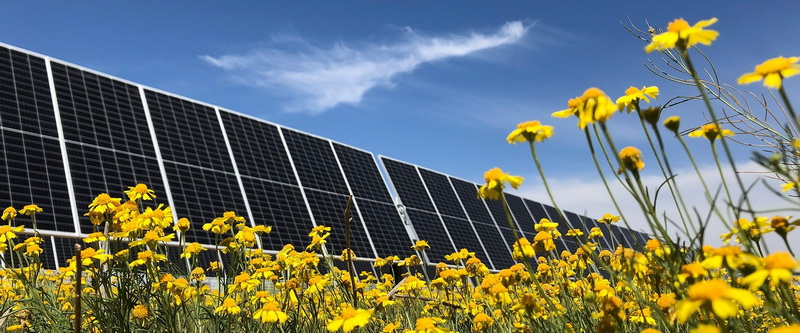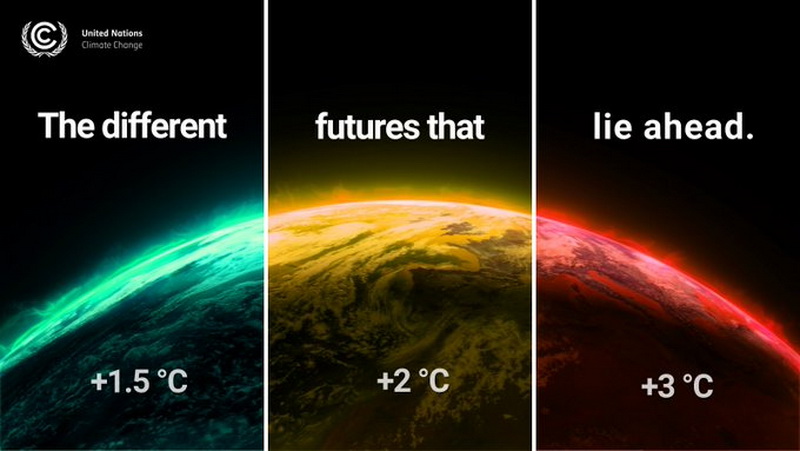The need for reducing greenhouse gases and preventing global climate change
Introduction
Global warming and climate change are significant and pressing issues in today's world. The production of greenhouse gases, including carbon dioxide, methane, and nitrogen oxide, poses a major challenge that requires reducing their emissions and eliminating past emissions. This challenge has captured global attention. While taking individual actions may not yield significant results alone, collectively, we can make small contributions to this important cause by taking minimal steps.
Achieving Zero Annual Production of 51 Billion Tons of Greenhouse Gases Worldwide
In the context of climate change, the staggering figure of 51 billion tons holds great significance. Unfortunately, this number continues to rise each year, posing a significant threat to our planet. The consequences of unchecked greenhouse gas emissions can already be observed through extreme weather events such as violent storms, floods, and droughts. It is crucial that we take immediate action to bring this number down to zero, or even negative. While this task may be extremely challenging, it is both necessary and unavoidable, as the fate of humanity is intertwined with addressing this issue.
Upon closer examination, it becomes evident that every individual contributes to greenhouse gas production on a daily basis through activities in various sectors such as electricity usage, animal farming, agriculture, industrial processes, construction, and transportation. It is important to recognize that we are all part of the problem. While we have made some progress in reducing greenhouse gas emissions, we need to place greater emphasis on designing and developing new tools and technologies in order to achieve our goal by 2050.
The utilization of renewable energy sources, such as wind and solar power, has shown great promise in tackling this problem. However, there is a need for more substantial efforts to expand their use and develop them as viable alternatives to polluting energy sources. Admittedly, relying solely on these energy sources may not provide us with the required energy demands due to the intermittent nature of sunlight and wind. Nevertheless, their proper and effective integration into our energy systems can gradually guide us toward our ultimate goal.
Consider the climate crisis as a bathtub slowly filling with water. Even if we manage to reduce the inflow of water, the bathtub will eventually overflow. This analogy illustrates the impending disaster we are faced with, and it is imperative that we take preventive measures.
Although the global spread of the coronavirus and subsequent economic downturn have temporarily decreased greenhouse gas emissions, the reduction is not significant enough to alleviate our concerns. In fact, despite emitting approximately 5% less greenhouse gases compared to pre-pandemic years, this slight decrease still amounts to around 48 billion tons of greenhouse gas emissions.
In conclusion, it is evident that we urgently require carbon-free solutions in various sectors such as transportation, electricity generation, food production, construction, heating, and cooling. Replacing existing energy sources with carbon-free alternatives is crucial. It is important to emphasize that energy consumption worldwide will not decrease; in fact, due to advancements in these sectors and population growth by 2050, our energy demands will only increase.

The Importance of Reducing Greenhouse Gases
Greenhouse gases play a significant role in trapping heat and raising the average surface temperature of the Earth. This means that higher levels of greenhouse gases lead to higher temperatures. Once these gases enter the Earth's atmosphere, they persist for extended periods, varying depending on the type of gas released. For example, carbon dioxide can remain in the atmosphere for up to 10,000 years. Therefore, even if we cease greenhouse gas production entirely, the Earth's temperature will still remain warm unless we gradually decrease the amount of these gases by developing innovative tools and striving to eliminate them from the atmosphere.
The truth is, we cannot continue producing greenhouse gases without contributing to global warming. Consequently, we must not only halt the production of additional greenhouse gases but also remove some of the gases already produced. To illustrate, imagine a bathtub where we not only stop the inflow of water, but also remove the drain plug, allowing the water to flow out of the tub.
It is crucial to note that while carbon dioxide is the most prevalent greenhouse gas, other gases like nitrogen oxide and methane exist. Many of these gases have the potential to raise the Earth's temperature more than carbon dioxide does. Methane, for instance, is relatively short-lived in the atmosphere, yet it possesses 120 times the warming capacity of carbon dioxide. As a result, methane can have a more significant destructive impact due to its ability to rapidly increase temperatures.
Title: The Mechanism Behind Greenhouse Gases
Greenhouse gases play a crucial role in our planet's climate system. When sunlight passes through the Earth's atmosphere, it penetrates most greenhouse gases and reaches the surface. However, not all of this energy is released back into the vacuum of space immediately. Instead, some of it is absorbed by molecules of greenhouse gases in the atmosphere.
This absorption leads to an increase in the vibrations of these molecules, resulting in the warming of the Earth's atmosphere. It is this phenomenon that is responsible for the greenhouse effect. Without the presence of appropriate amounts of greenhouse gases, such as carbon dioxide, methane, and water vapor, the Earth would be significantly colder, making it uninhabitable for life as we know it.
The intricate balance of greenhouse gases creates a stable and habitable environment for diverse forms of life on our planet. Understanding the role of greenhouse gases is crucial in recognizing and addressing the impacts of human activities on the Earth's climate.
Global Warming and Environmental Disasters
It is important to note that the Earth's temperature has increased by at least one degree Celsius since pre-industrial times. If we continue on this path, it is projected that by 2050, the temperature may increase between 1.5 and 3 degrees Celsius. By the year 2100, the temperature could rise between 4 and 8 degrees Celsius. These changes are expected to have catastrophic and destructive effects.
As global temperatures rise, sea levels will also increase, resulting in coastal flooding and submergence of areas such as parts of Bangladesh which are already experiencing these challenges. Storms will become more intense, contributing to heightened risks of destructive floods and tornadoes. There is also a greater risk of intensified forest fires, leading to increased destruction of structures and agricultural products.
Furthermore, these environmental changes will have significant impacts on life forms. Research suggests that a two-degree Celsius increase in temperature could lead to an 8% reduction in the geographical range of vertebrates, a 16% reduction for plants, and an 18% reduction for insects. Additionally, food production may decrease by approximately 50%, significantly threatening global food security.
It is evident that urgent action is required to mitigate the impacts of global warming and prevent further environmental disasters.

The Relationship Between Heat Stroke and Climate Change
Heatstroke is a significant problem related to humidity as the air's capacity for holding water vapor becomes saturated. This saturation prevents the air from absorbing additional moisture, impeding the body's ability to cool itself through sweating. As a result, the body temperature remains high, leading to heatstroke and potentially death. Research suggests that climate change could become as deadly as Covid-19 by 2050 and up to five times more deadly by 2100.
Fossil Fuels
Fossil fuels have become ingrained in various aspects of our daily lives, contributing significantly to greenhouse gas emissions. These emissions are present in items such as toothbrushes, bread, hamburgers, clothing, vehicles, roads, building materials, and heating/cooling systems. With more than 4 billion gallons of oil being extracted and used each day worldwide, it is unrealistic to expect an immediate halt to production and consumption.
Transformation in Energy: Our Current Need
The transformation in energy that we require today is crucial for various reasons. We need to shift towards more affordable and sustainable energy sources. While fossil fuels are cheap and energetically potent, solar panels have not yet reached high levels of efficiency. The current efficiency of silicon solar cells stands at 25%, which may not be sufficient to replace traditional energy sources.
International Cooperation to Reduce Carbon Emissions
Establishing global cooperation in reducing carbon emissions is an immensely challenging task, particularly when it comes to convincing countries to bear the costs associated with limiting emissions. Achieving these goals necessitates collective action from every country worldwide. The Paris Agreement, signed by over 190 countries, is considered a notable achievement. However, implementing the provisions of this agreement and successfully decarbonizing economies is far from simple.
Greenhouse Gas Production by Sector
When evaluating greenhouse gas production, it is essential to consider the various sources contributing to these emissions. Although the general public often associates electricity production and cars as the primary contributors, it is crucial to note that the transportation sector alone accounts for just 16% of greenhouse gas emissions. The table below provides an overview of greenhouse gas emissions by sector.

Achieving Clean Electricity Solutions
The great news is that the generation of electricity contributes to 27% of greenhouse gas emissions, and this substantial percentage can be mitigated by transitioning to clean sources of electricity. While producing clean electricity alone may not result in zero emissions, it is a crucial step towards resolving this issue.
It should be noted that generating sufficient electricity for a city cannot solely rely on building power plants that match the city's consumption. This is due to the fact that some energy sources are intermittent, such as solar and wind power, as they depend on weather conditions. Conversely, nuclear power plants and fossil fuel power plants have the ability to operate continuously for 24 hours. Estimations suggest that wind and solar power plants can fulfill up to 30% of the required capacity. Therefore, alternative energy sources must be utilized to generate the remaining electricity needed.
Maximizing Electricity Generation per Square Meter
It is important to consider that certain power plants require a larger area for operation. At first glance, space may not seem significant, but what truly matters is the efficiency of electricity production within a given space. The table below illustrates the efficiency levels of different power plants at specific capacities.

Please note that this comparison does not imply that solar energy, for instance, is more suitable than wind energy. It is important to acknowledge that both forms of energy can be utilized in specific environmental conditions.
Positive and Negative Green Prices
It is important to note that currently, most carbon-free solutions are much more expensive than resources such as fossil fuels. This price difference between clean sources and carbon-producing sources is referred to as the green price. There are very few cases where the green price is negative, meaning that green fuels cost the consumer less than fossil fuels. For example, costs can be reduced by replacing heat pumps with coolers and heaters. Although this technology may already be in use worldwide, it will take years for people to abandon their old technologies and adopt these new ones.
Electricity Generation Methods
At the beginning of the emergence and use of electricity, the primary source of electricity production was hydroelectric power plants. Hydroelectricity has many advantages and is cost-effective. However, building a dam can cause significant environmental problems, including displacement of settlements and wildlife. Additionally, if there is a substantial amount of carbon in the soil of the area, building a dam can lead to the release of methane into the atmosphere. Studies have shown that it can take several decades or even a century for a dam to offset all the methane emissions, which is worse than using a fuel like coal. Furthermore, dams are fixed structures that require a suitable location with a sufficient water supply.
In contrast, fossil fuels do not have these limitations and can be used anywhere to produce steam and generate electricity through turbine rotation. Research has shown that the cost of using fossil fuels to produce electricity has significantly decreased over time. In 2000, electricity generation was at least 200 times cheaper compared to 1900.

The use of fossil fuels as energy sources for electricity generation is the primary reason for the low cost of electricity. These fuels are readily available and inexpensive, making them responsible for more than two-thirds of the world's electricity supply.
Fortunately, green energy prices are low in advanced countries like the United States and Europe, leading to an increasing demand for clean electricity. In 2021, the decarbonisation of the European electricity grid is projected to only result in a 20% price increase, which is promising for the continuation of this trend.
It is important to note that not all countries possess abundant renewable resources or have the necessary capital to construct new renewable energy power plants. However, it should be acknowledged that while gas power plants, despite their affordability, always require the purchase of fuel, wind and solar power plants utilize free energy. As a result, as we expand the scale of these power plants, they will inevitably become cheaper in the long run.
As previously mentioned, a significant challenge lies in transporting large quantities of clean energy from where it is generated to where it is needed. This necessitates the construction of new power transmission lines, which is both time-consuming and expensive, particularly when crossing international borders. Moreover, as more power transmission lines are built, electricity prices will rise. In fact, one third of the final cost of electricity can be attributed to transmission and distribution.
Nevertheless, it is crucial to recognize that our main obstacle to providing clean electricity is not just the affordability of fossil fuels or the high expense of constructing transmission and distribution networks. The primary issue lies in securing uninterrupted power supply. As mentioned earlier, the sun does not shine constantly, and the wind does not always blow. Therefore, if we solely rely on these intermittent energy sources, it is imperative that we find a way to store the generated electricity so that we can utilize it during periods when the sun is not shining and the wind is not blowing.
One potential solution that comes to mind is utilizing batteries for energy storage. However, it becomes evident that this option is currently not feasible when we consider the scale of city-wide electricity consumption rather than just powering individual devices. Potential alternatives include using fossil fuel electricity during power outages or implementing large-scale battery systems for nighttime usage. It should be noted, however, that the cost of such measures would exceed three times the daily electricity production, rendering them uneconomical. Additionally, the cyclical nature of solar energy due to day-night variations and seasonal changes poses challenges. Wind energy faces similar issues and can vary significantly based on seasonal fluctuations.
It is predicted that global electricity consumption will double or even triple by 2050. Therefore, investing in clean energy sources can play a significant role in reducing greenhouse gas emissions. To achieve this, efforts must be directed towards developing cheaper and more efficient solar and wind panels.

Ways to Produce Carbon-Free Electricity
Solar Energy
The first crystalline silicon solar cells were introduced to the market in the 1970s. Initially, these cells could only convert 15% of received energy into electricity. However, technological advancements have increased this efficiency to 25%. Theoretically, it is possible for these cells to convert up to 33% more solar energy into electricity, which would be highly beneficial.
While it is true that the current cost of generating electricity from solar energy is slightly higher than fossil fuels, it is important to note that the cost of solar cells has decreased significantly. From 2010 to 2020, solar cells have become nearly 10 times cheaper. Additionally, solar energy does not require any raw materials to produce electricity, resulting in long-term economic savings.
Nuclear Fission
Nuclear power is the only carbon-free energy source capable of producing large-scale electricity 24 hours a day, regardless of season or location. France and the United States are the leading producers of nuclear power, accounting for 70% and 20% respectively. Compared to other clean energy sources, nuclear energy requires approximately 10-20% more materials to generate electricity.
However, it is important to acknowledge the major problems associated with nuclear power plants. They are expensive to build, prone to accidents caused by human error, can potentially contribute to the production of nuclear weapons, and generate hazardous waste that is difficult to store. It is worth noting, though, that nuclear energy has only accounted for 0.07% of deaths caused by electricity production. Coal (24.6%), oil (18.4%), and gas (2.8%) pose greater risks in terms of human casualties.
To address the challenges related to nuclear fission, scientists and engineers have proposed various solutions. One notable solution is the design of the Trapower reactor, created by a supercomputer in Washington. This reactor, powered by waste from other nuclear power plants, produces a minimal amount of nuclear waste. Its fully automated operation eliminates the possibility of human error. Moreover, the reactor features expandable fuel pins to prevent overheating and a possible explosion. Although construction permission is currently lacking, this concept holds potential for future implementation.
Nuclear fusion
Another type of nuclear energy that is very promising, but will take at least another decade to produce electricity, is nuclear fusion. Fusion is the process that provides the sun's energy. The process starts with a gas like hydrogen. This gas is heated to 50 million degrees Celsius. At this temperature, the particles move so fast that they collide and fuse. When hydrogen particles fuse together, they turn into helium and in this process a lot of energy is released that can be used to generate electricity.
Although fusion is still in the laboratory phase, it has a bright future because it works with accessible elements like hydrogen, and the fuel required for it is cheap and abundant. The type of hydrogen needed to be used in these types of power plants is obtained from sea water, and what we have to use a lot is sea water. Also, the waste produced in this type of nuclear energy is much less radioactive, and unlike the type of nuclear fission that is radioactive for hundreds of thousands of years, it remains radioactive for only a few hundred years. Also, there is no chain reaction in nuclear fusion that goes out of control, and this issue minimizes the dangers of this energy. The only major disadvantage of this type of power plant is that it requires a lot of energy. Because of this, most of the time, you have to spend more energy than you get.
In this context, the biggest project under construction is the cooperation project between six European Union countries, which have built relevant laboratory facilities in the south of France. This project started in 2010 and probably in 2030 it can generate additional electricity about ten times the electricity it needs for consumption. This event can be one of the biggest achievements of mankind to reduce the production of greenhouse gases.

Offshore Winds
Given that many major cities are located near the sea, there is an opportunity to harness the power of offshore winds, which are typically consistent. This makes the issue of intermittent supply less problematic in this case. According to the presented statistics, the utilization of offshore wind has been growing at an average rate of 25% annually. Currently, countries like England and China have made significant investments in this field. China is projected to become the largest consumer of offshore wind energy by 2030.
Geothermal Energy
As you may know, deep within the Earth, between 30 meters to 1.6 kilometers, there are hot rocks that can be used to generate electricity through a process called carbon base energy generation. This involves pumping water at high pressure into these rocks, where it absorbs heat and then exits through another narrow hole to turn a turbine or flow through other rocks to produce electricity. However, this method has its drawbacks, as approximately 40% of the wells created for this purpose remain unused. Additionally, this type of energy is only accessible in select regions of the world, particularly areas with active volcanoes.
Cutting-Edge Electricity Storage Methods
Battery Advancements
Enhancing the efficiency of lithium-ion batteries, commonly used in electronic devices like cell phones and consumer electronics, presents a challenge due to limited understanding of their composition. Researchers are exploring alternative materials to develop batteries as metals alone seem insufficient. Consequently, the usage of these battery types is on the rise, but substantial advancements may be difficult to achieve. Nevertheless, there have been recent developments concerning the use of liquid metals in storing significantly higher quantities of energy at a faster rate. Such progress aligns with the goal of widespread electrification in urban areas.
Pumped-storage Power Plant
In this method, when electricity is available at a low cost, such as during peak sun or high wind speeds, water is pumped to a reservoir located uphill. When the stored electricity is needed, the water is released downhill and used to turn a turbine, generating electricity.
Another company has introduced a new concept for this process. Instead of storing water in an above-ground reservoir, they propose pumping water underground and maintaining it under pressure. This water can then be released as needed to turn a turbine. Implementing this idea would eliminate the need for overhead equipment and the presence of upstream land points, marking a significant development in this field.
Thermal Storage
In this method, excess electricity is utilized to heat a specific substance. Later, when more electricity is required, the stored heat is used to generate electricity via heat engines. These engines typically operate with an efficiency of 50 to 60%, which can be considered relatively acceptable. Scientists are actively working to further increase this efficiency. Recently, they have achieved progress by employing molten salt.
Affordable Hydrogen
Typically, batteries derive their energy from a chemical reaction between two gases, commonly oxygen and hydrogen, with the only byproduct being water. Hence, we can produce hydrogen from solar and wind-generated electricity and store it under pressure. When needed, this hydrogen can be utilized in fuel cells.
The challenge associated with this method is the high cost of hydrogen production without greenhouse gas emissions. Moreover, the efficiency of storing electricity in batteries is not optimal since energy is first used to produce hydrogen and then hydrogen is utilized to generate electricity. This results in energy wastage. Additionally, due to hydrogen's lightweight nature, storing it poses difficulties. Hydrogen molecules, being small in size, can escape through the container walls, typically constructed of metals.

Title: How to Produce Environmentally Friendly Building Materials?
Concrete is a highly versatile and widely used building material due to its resistance to rust, anti-rot properties, and non-flammability. Its popularity is evident in the construction of most buildings today, as well as in the creation of hydroelectric dams. However, it's important to acknowledge that concrete consumption is substantial worldwide.
In addition to cement and concrete, steel is abundantly used in various industries, such as construction, automobile manufacturing, shipbuilding, household appliances, and food cans. Steel's affordability and durability make it a popular choice. In construction, steel bars are often utilized as reinforcement to enhance the strength of concrete.
Plastics play a significant role in numerous applications, ranging from clothing and toys to cars and cell phones. While plastics sometimes have a negative reputation, they offer numerous benefits in modern human life.
Glass finds widespread usage in industries related to food, construction, and manufacturing.
Another commonly used metal is aluminum, which can be found in soda cans, airplanes, trains, and other tools and devices.
Considering all these materials, it becomes clear that they are an integral part of modern life, and their use cannot be easily eliminated. As the world becomes more prosperous, and the population grows, the demand for these materials continues to increase.
The crucial question arises: how can we produce these materials without causing harm to the environment? In this context, we will focus on plastic, steel, and concrete to explore environmentally friendly production methods.
To produce steel, the oxygen must be removed from iron, and a small amount of carbon needs to be added. This process involves melting iron at temperatures exceeding 1700 degrees Celsius while using a type of coal called coke in the presence of oxygen. Carbon is released during this process, although a portion remains with the iron and steel being produced. Roughly speaking, the production of one ton of steel is equivalent to emitting 1.8 tons of carbon dioxide. It's important to note that despite its widespread usage due to cost-effectiveness, this method contributes significantly to carbon emissions.
Cement production requires calcium, which is obtained from limestone. Limestone naturally contains calcium, carbon, and oxygen. By burning limestone in a furnace, we obtain calcium and carbon dioxide, with the former being essential for cement production. Unfortunately, there aren't currently any alternative methods known for obtaining calcium from limestone. It is worth mentioning that approximately one ton of carbon dioxide is emitted for every ton of concrete produced using this process.
Plastic is a material that significantly contributes to carbon dioxide emissions. It was developed in the 1950s thanks to advancements in chemical engineering. Today, there are around twenty different types of plastic, all of which share one common aspect: carbon dioxide. Carbon combines with elements like oxygen and hydrogen to create plastic. However, there is an important distinction between plastic and materials such as steel and concrete. When steel and concrete are produced, carbon dioxide is released into the atmosphere, whereas when plastic is made, about half of the carbon remains within the plastic. This is because carbon has a tendency to bond with oxygen and hydrogen and does not easily separate from these two elements, resulting in the slow decomposition of plastic over hundreds of years.
Besides plastic, there are other materials like glass, fertilizer, aluminum, and paper that undergo similar production processes, leading to significant greenhouse gas emissions. Together, the production of these materials accounts for approximately one third of global greenhouse gas emissions. Cement production is the most challenging in terms of changing its production process, although several companies have recently been working on innovative ideas.
One proposed method involves capturing carbon dioxide emitted during cement production and injecting it into cement before it is used in construction. So far, this method has achieved a ten percent reduction in greenhouse gas emissions, but there is hope that it could eventually absorb up to 33 percent of the carbon produced by cement.
Another theoretical approach that has yet to be implemented suggests using seawater and carbon dioxide absorbed from various power plants for this purpose. Scientists working on this issue believe that this method could prevent up to 70% of greenhouse gas emissions in the cement production sector.
Overall, it is crucial to prioritize the production of clean and reliable electricity to address the need for these materials. Interestingly, the production sector currently consumes about a quarter of the world's electrical energy. Therefore, it is essential to generate and store clean or carbon-free electricity affordably. If this can be achieved, it may offer a solution to the plastic problem, as plastic could potentially be transformed into a carbon sink produced by other factories. This method could serve as a means of carbon removal. By effectively fitting these puzzle pieces together, we can strive towards reaching zero carbon emissions and even making them negative. In simple terms, this means capturing carbon from the air and storing it in a plastic container that can be used for centuries without emitting greenhouse gases.

How to Minimize Greenhouse Gas Emissions from Animal Agriculture and Plant Cultivation
Animal breeding, agriculture, and deforestation for food production are significant contributors to greenhouse gas emissions, accounting for approximately 19% of all greenhouse gases. While carbon dioxide production is not the main concern when it comes to plant and animal cultivation, it is worth noting that methane gas plays a major role. Surprisingly, one molecule of methane can warm the Earth 28 times more than a molecule of carbon dioxide over a century, while nitrous oxide can have an impact 265 times greater than carbon dioxide.
Based on available statistics, the combined emissions of nitrous oxide and methane exceed 7 billion tons, representing more than 80% of greenhouse gases related to agriculture and animal breeding. With population growth and the increasing demand for diverse and improved nutrition, these emissions are expected to rise annually unless we address the issue promptly. To achieve zero greenhouse gas emissions, it is crucial to contemplate methods for reducing emissions in agricultural and animal farming processes until they eventually reach zero.
To avoid future challenges, substantial progress is necessary, comparable to the advancements made by Norman Borlaug. Borlaug's agricultural revolution resulted in increased wheat yields by three times and larger grain sizes.
The worldwide population of more than one billion cows serves as a source of meat and dairy products. The burping and flatulence of cows alone contribute to 2 billion tons of carbon dioxide emissions per year, equivalent to 4% of the total greenhouse gases produced annually. Other livestock animals such as sheep, goats, and camels also contribute to this category. Additionally, animal feces pose another problem in this field. The excrement of these animals, particularly cows and pigs, contains high levels of nitrous oxide, methane, sulfur, and ammonia, making them the second significant factor in greenhouse gas emissions within this sector.
Measures to Reduce Burping, Flatulence, and Feces Emission in Animals
Scientists have been working on reducing the presence of methane-producing microbes in the intestines of cows by developing vaccines, specialized food, and drugs. The most successful methods have resulted in a 30% reduction in pollution, but they require daily administration of medicine or special food to the animals.
While removing meat from the food basket may seem like a viable solution, it is challenging due to its significant cultural presence in human society. However, reducing meat consumption and opting for plant-based alternatives can be a better option for the environment as it reduces emissions, water and land usage, and animal suffering.
Currently, the cost of producing artificial meat is significantly higher than natural meat, approximately 86% more expensive. However, with advancements in production methods and increased availability of food substitutes, the price is expected to decrease in the future. Some companies are also exploring lab-grown meat options, such as "clean meat" and "cultured meat," but mass production and necessary permits are still pending.
Another effective approach is reducing food waste, which emits methane gas when discarded or rotten. Companies have developed invisible coatings for fruits and vegetables to extend their shelf life without posing harm to humans.
In mass agricultural production, nitrogen is crucial for plant growth and productivity. As plants require a continuous supply of nitrogen, synthetic fertilizers like ammonia are used. However, these fertilizers have drawbacks, including the need for heat production through burning natural gas, leading to greenhouse gas emissions. Moreover, only half of the nitrogen in fertilizers is utilized by plants, causing soil and groundwater pollution as well as the release of nitrous oxide, a highly dangerous gas.
To address this issue, scientists have developed methods to create bacteria in the soil that can produce and fix sufficient quantities of nitrogen for plant growth. Implementing these methods on a large scale could eliminate the dependence on synthetic fertilizers.
The aforementioned measures primarily target the greenhouse gas emissions associated with the production of human food, accounting for about 70% of emissions in this sector. The remaining 30% is linked to deforestation. It is important to note that when replacing trees, they should be of the same species and region as the ones that were removed.

How to Reduce Greenhouse Gas Emissions from Travel
In general, vehicles used for both passenger and cargo transportation are responsible for a significant portion, around 16%, of global greenhouse gas emissions. This statistic may surprise you, as the impact of transportation on emissions is often underestimated.
It is interesting to note that the energy contained in one gallon of gasoline is equivalent to that of 130 sticks of dynamite. While dynamite releases its energy all at once, gasoline burns at a slower rate, making it suitable for powering vehicles. In comparison to other fuels like diesel and jet fuel, gasoline remains the most affordable option, providing substantial energy. If we observe closely, we will find that gasoline is even cheaper than milk and orange juice.
In order to achieve zero greenhouse gas emissions, we must seek alternative fuels that can power cars, ships, and planes with the same level of energy efficiency and affordability as fossil fuels. After relying on fossil fuels for over two centuries, finding a suitable replacement is a crucial priority. However, it is important to acknowledge that passenger cars are not the sole contributors to carbon dioxide emissions and air pollution. Other modes of transportation, such as cargo ships, also significantly contribute to greenhouse gas emissions, accounting for approximately 3% of total emissions.
The focus should be on identifying sustainable alternatives for all types of vehicles to effectively combat climate change and reduce air pollution.

All Types of Cars and Motorcycles
Today, it is easy to purchase an all-electric car from leading car manufacturers around the world. Although electric cars are more expensive than gasoline-fueled cars, this price difference has been decreasing in recent years and is expected to continue decreasing in the future. It is important to note that electric cars have lower operating costs and run on electricity as fuel. Predictions suggest that by 2030, the price difference between electric cars and gasoline cars will be eliminated, resulting in a higher adoption of electric vehicles in cities.
One disadvantage of electric cars is the time it takes to charge them, which can require an hour or longer. In contrast, filling up a car with gas takes less than 5 minutes. However, it is crucial to consider that if we aim to use electric cars to reduce greenhouse gas emissions, the electricity used to charge these cars must come from clean and carbon-free sources to achieve this goal.
Another approach to address this issue is the utilization of alternative liquid fuels that capture carbon from the atmosphere and release the same amount when burned. This would result in maintaining a constant level of greenhouse gas emissions.
When considering alternative fuels, ethanol often comes to mind. Ethanol is a biofuel typically produced from sugarcane, corn, or sugar beet. It is interesting to note that a significant portion of fuels used in the United States contains 10% ethanol derived from corn. In countries like Brazil, there are cars that run exclusively on 100% ethanol fuel obtained from sugarcane. Similar trends exist in other nations, making ethanol a widely utilized component in fuel production.
However, it should be examined more closely that ethanol production still generates carbon emissions. The cultivation of corn necessitates the usage of fertilizers, while purification after harvesting releases pollutants. Additionally, land designated for ethanol production could be utilized for growing crops to meet human food demands. Furthermore, expanding agricultural land for ethanol production may lead to deforestation.
Nevertheless, not all alternative fuels encounter these issues. For instance, if we utilize agricultural waste or garbage for biofuel production, there would be no need for additional land, fertilizers, and related concerns.
Certain advanced biofuels have the potential to completely replace fossil fuels without requiring substantial government expenditures on new vehicles or pipelines. However, further research and development are still necessary.
It is important to note that producing substitute fuels is not limited to the methods mentioned above. Carbon-free electricity can also be used to combine hydrogen obtained from water with carbon dioxide to produce hydrocarbon fuels. These types of fuels, known as electric fuels, offer various advantages. One significant advantage is that they utilize atmospheric carbon dioxide, thus not contributing to existing pollution levels. Nevertheless, the production of this fuel has its own drawbacks. Firstly, it can be costly, and secondly, producing hydrogen without carbon emissions can also be expensive. It is worth mentioning that clean electricity should be used in the production process to align with our environmental goals.
In conclusion, alternative fuels provide a promising pathway towards reducing greenhouse gas emissions in transportation. Electric cars, biofuels, and electric fuels all play a role in mitigating environmental impacts. Ongoing efforts are required to improve the affordability, efficiency, and sustainability of these solutions.
Trucks, Buses, and Trolleys
When it comes to long-distance trucks and buses, batteries are not an ideal option. The larger the vehicle and the greater the required distance, the more challenging it becomes to rely on electricity for engine power. Batteries are heavy and have limited energy storage capacity, making it more difficult to propel a truck. However, city buses and small trucks that operate within cities can be considered suitable for battery use.
With a rough calculation, we find that currently, the best lithium and ion batteries can produce only one-thirty-fifth of the energy provided by gasoline. To achieve the same performance as gasoline-powered vehicles, we would need batteries weighing 35 times more than the gasoline they replace. This issue becomes even more evident when considering the space occupied by batteries. To travel approximately 1000 km, around 25% of the space in trucks would need to be dedicated solely to batteries. Beyond a distance of 1500 km, batteries become impractical for use.
Cargo Ships, Pleasure Boats, and Airplanes
It's important to note that even the most advanced all-electronic airplanes can only accommodate two passengers and have a maximum speed of 350 km/h. These aircraft can fly for approximately 3 hours. In contrast, the Boeing 787 can transport around 296 passengers, reach speeds of about 1000 km/h, and has an approximate flight duration of 20 hours. Currently, fossil fuel-based aircraft can fly up to three times faster, six times longer, and support 150 times more passengers.
While batteries are showing progress, it remains uncertain whether they will bridge this substantial gap in the future. Therefore, alternative fuels such as electric fuels and advanced biofuels are the most promising substitutes for traditional airplane fuels.
Similar considerations apply to ships, as fossil-fueled cargo ships can carry up to 200 times more cargo and travel about 400 times further than electric ships. Notably, ships contribute 3% of global greenhouse gas emissions, making the adoption of clean fuels crucial in addressing this environmental issue. However, finding a suitable replacement for cheap bunker fuel derived from oil refining waste poses significant challenges.
To calculate the cost of adopting green fuels in the transportation sector, the following table can be used.

While using nuclear energy to power large cargo ships can be a viable option, it is important to consider all of its potential aspects and risks. Currently, ships, submarines, and even military planes use this method, but the associated dangers have limited its widespread adoption. However, with advancements in technology and the resolution of these issues in the coming years, it may become a suitable alternative to replace fossil fuels in transportation.
Another crucial factor to consider is the need for a significant increase in clean electricity to support the aforementioned systems. This highlights the importance of utilizing renewable resources and making substantial progress in the field of production and storage of these resources.

Providing Efficient Heating and Cooling Solutions
The heating and cooling sector contributes approximately 7% of environmental pollutant emissions. Currently, about 90% of American households and workplaces rely on air conditioning systems. Additionally, the increasing use of advanced technologies like large servers generates significant heat, necessitating the continuous use of air conditioning systems to keep them cool.
Aside from air conditioning, water heaters also consume substantial amounts of energy. According to forecasts, global electricity demand for cooling is expected to triple by 2050, equivalent to the current combined electricity consumption of China and India. This increase poses a significant challenge in terms of carbon emissions, as electricity production often involves carbon-intensive processes. Consequently, buildings' electricity usage accounts for around 14% of total global greenhouse gas emissions.
Moreover, the issue lies not only in electricity consumption for air conditioning but also in the use of fluorine-based refrigerants that can be harmful to the environment when released into the atmosphere. Interestingly, these refrigerants can be thousands of times more detrimental to global warming than carbon dioxide.
Recognizing the urgency, countries have committed to an 80% reduction in the use of such refrigerants by 2045. This commitment aims to encourage the adoption of alternative, less harmful substances for cooling purposes.
Notably, heating devices and water heaters contribute to one-third of greenhouse gas emissions in buildings worldwide. Unlike other appliances, these systems predominantly rely on fossil fuels like gas and oil, varying depending on the region. Consequently, transitioning to zero-carbon heating and cooling requires not only cleaning up the electricity grid but also finding sustainable alternatives to oil and gas for heating buildings.
The approach to achieving zero carbon in the heating sector mirrors that of the automotive sector - extensive electrification and the use of cleaner fuel sources for other essential components. Encouragingly, electrifying heating systems, particularly using electric heat pumps instead of gas or oil, presents a cost-effective and environmentally friendly alternative. In fact, the cost of adopting these energy-efficient heating and cooling devices can even become more affordable than current options, potentially offering a negative green surcharge.
Heat pumps operate by circulating a coolant through pipes in a closed loop, causing gases and liquids to change temperature due to expansion and contraction. During winter, heat pumps extract heat from the outside environment and transfer it into the house, while in summer, they reverse the process, expelling heat from within the house to the outside. This method allows for efficient heating and cooling throughout the year.
Last Word
In this article, we have presented the five main sources of greenhouse gas emissions. We begin with electricity generation, followed by the manufacturing and production of products. Additionally, we discuss food supply, specifically the cultivation of plants and animals. Next, we delve into the widespread usage of vehicles across the globe, and finally, we provide an example of heating and cooling devices. It is our hope that these topics provide you with a clearer understanding.
Firstly, the issue at hand is highly complex, and all these problems stem from human activities. Secondly, we currently possess tools that can aid in reducing greenhouse gas emissions. Thirdly, however, the existing tools are not sufficient, necessitating a decrease in their environmental impact. Furthermore, it is imperative that we employ innovative and efficient methods to replace the current ones.
Author: Farhad Naji




